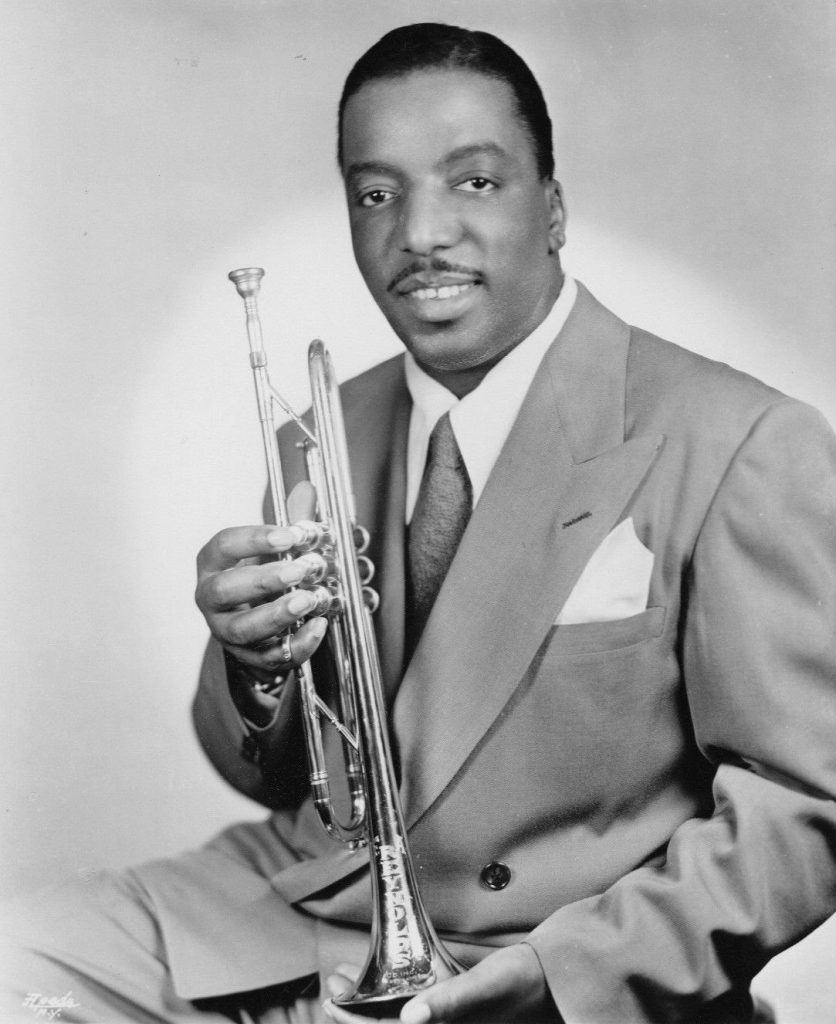
He was billed as “the 20th Century Gabriel” because of his high-note work and flamboyant solos. Very popular during his heyday and the leader of one of the most swinging bands of the Swing era, trumpeter Erskine Hawkins is often overlooked today. Even his famous original “Tuxedo Junction” is best remembered as being a hit for Glenn Miller. But as his scores of rewarding recordings show, Hawkins led one of the most consistently hot big bands of the Swing era.
Erskine Ramsay Hawkins was born on July 26, 1914, in Birmingham, Alabama. He began playing music as a drummer when he was seven, switched to trombone after a few years, and settled on the trumpet when he was 13. He was well trained and developed impressive technique on the trumpet along with a wide range. Hawkins attended the Alabama State Teachers College in Montgomery, Alabama, played with the school band (known as the ’Bama State Collegians), and was soon appointed its leader. In 1934 the 20-year old trumpeter brought the members of the group to New York to raise money for the school. The ensemble had such strong success playing at the Savoy Ballroom that they soon became pros and split permanently from the college. By 1938 the ’Bama State Collegians were renamed the Erskine Hawkins Orchestra.
While their first recording date on July 20, 1936, found the band mostly in a supportive role behind singers Billy Daniels and Merle Turner, Hawkins’ second session (from Sept. 8) featured the orchestra romping on “Swinging In Harlem” and “Big John’s Special.” From then on, the great majority of their recordings were instrumentals and ideal for both dancing and listening by jazz fans.
The Erskine Hawkins Orchestra would have remarkably few changes in personnel during the next six years, being very much a family band. While all of the musicians in the band were excellent, five of Hawkins’ sidemen were major standouts.
Few seemed to realize it at the time but most of the trumpet solos on the Erskine Hawkins records through 1942 were not by the leader but by Dud Bascomb (1916-72). Frequently Hawkins would be heard at the climax of songs, blasting a few high notes, but the medium-register swing solos were often taken by Bascomb. Born as Wilbur Odell Bascomb, he was part of the band from its origin in 1932 until 1944. Bascomb left at that time to join his brother Paul Bascomb’s group. He had a brief stint with Duke Ellington in 1947, played later on with tenor-saxophonist Sam “The Man” Taylor, Buddy Tate, and James Brown, had his own combo for 15 years, and often worked in the studios and in the pit orchestras of Broadway shows. Bascomb led three big band dates during 1945-46 and a few combo sessions for Savoy during 1959-61. His last recording was a reunion album with Hawkins in 1971 that typically did not identify the soloists.
Paul Bascomb (1912-86), who was four years older than Dud, was also a founding member of the ’Bama Street Collegians in 1932. His warm and booting tenor solos became an important part of the orchestra. He left Hawkins in 1938 to join Count Basie when Herschel Evans passed away but rejoined the band in 1939. His only recording with Basie was when he guested on a slightly later session (Dec. 13, 1940). After permanently leaving Hawkins in 1944, he led a septet that grew to be a big band although he only recorded with the small group. Bascomb led a variety of sessions during 1952-55 that fell between swing and r&b, he made no recordings during 1956-77 despite being active, and was documented as a guest soloist at the Nice Jazz Festival in 1978, jamming with the likes of Helen Humes, Vic Dickenson, Eddie “Lockjaw” Davis, Eddie “Cleanhead Vinson, Illinois Jacquet, and Carrie Smith. Paul Bascomb’s only recording after that was with a local band in Chicago headed by trumpeter Yves Simierciak in 1981, five years before his passing.
When Paul Bascomb first left Hawkins in 1938, his successor was Julian Dash (1916-74). Dash proved to be a perfect fit for his sound and style were quite similar to Bascomb’s. He had started out as an altoist, playing with the Charleston Nighthawks in 1935 and working with Hawkins during 1935-36 although he left the band before they made their first recordings. Dash spent time studying embalming but wisely decided to become a musician instead of a mortician! After leading the house band at Monroe’s Uptown House during 1936-38, he rejoined Hawkins and, when Paul Bascomb returned, Hawkins decided to keep both tenors. Dash stayed with Hawkins all the way into 1953, led a few obscure but rewarding combo dates, was featured on two of Buck Clayton’s jam session albums, and much later in his life was on two records by Jimmy Rushing (1967), one with Jay McShann (1972), and led half of an album with pianist Cliff Smalls in 1970.
Harry Carney was the first significant jazz baritone-saxophonist, joining Duke Ellington in 1927 and influencing all of the baritonists who would follow in the jazz world. When Haywood Henry (1913-94) first recorded with Hawkins, there were few other competitors. The baritone had not yet been widely adopted as an essential part of a big band’s saxophone section. Henry, whose first instrument was the clarinet, was a year older than Hawkins and was part of the ’Bama State Collegians as early as 1930. He took occasional baritone solos on many of the orchestra’s records, his playing was part of the group’s sound, and he was with the big band from its beginning until its very end. He was as loyal to Hawkins as Carney was to Ellington.
Henry made no recordings other than with Hawkins until 1949 when he began to freelance a bit, recording with Billie Holiday and Julian Dash among others. After leaving Hawkins in 1952, he became a studio musician whose baritone was heard anonymously on over 1,000 rock and roll records in the 1950s and ‘60s. Among his more jazz-oriented recordings were sessions with Ruth Brown, Earl Hines, Al Hibbler, Big Joe Turner, Sammy Price, Jimmy Rushing, Jimmy Witherspoon, the Fletcher Henderson Reunion Band, Illinois Jacquet, Ray Charles, Panama Francis, Willis Jackson, Eddie Harris, Sy Oliver, and Clark Terry. Henry toured and recorded with Earl Hines during 1969-71, was on a five-clarinet record with Jimmy Hamilton in 1981 (Tribute To Barney Bigard and Russell Procope), and stayed busy into the early 1990s. He also led four singles and three albums in his career; best-known is 1983’s The Gentle Monster.
Of the five major Hawkins sidemen, possibly the most significant was pianist Avery Parrish (1917-59) who had a tragic life. Born and raised in Birmingham, he joined the Erskine Hawkins Orchestra just in time to be part of their debut recording and stayed until 1942. Parrish became famous for composing and being showcased on their 1940 recording of “After Hours.” He also wrote occasional arrangements for Hawkins (including “Swing Out” and “Riff Time”). Parrish was an excellent swing and blues pianist who would have had a longer career and life were it not for three tragedies.
In Aug. 1942 he was in a car crash that killed one of Hawkins’ trumpeters, Marcellus Green. That helped lead to Parrish deciding to leave the orchestra. He moved to California where he had some success but a bar fight in 1943 resulted in him being hit in the head by a bar stool, becoming partly paralyzed, and being unable to play piano. He did record a remake of “After Hours” on a Dud Bascomb session in 1946 but otherwise his musical career was through and he was relegated to having day jobs. In 1959 it is believed that he fell down a flight of stairs in Harlem, passing away five days later.
The Erskine Hawkins Orchestra was a major attraction in Harlem during the second half of the 1930s, often alternating with Chick Webb at the Savoy Ballroom. While they played occasional ballads and vocal pieces, most of their recordings were swinging instrumentals with fine arrangements from trumpeter Sammy Lowe and altoist William Johnson. They recorded a steady string of exciting numbers which during 1936-39 included “Uproar Shout,” “I’ve Found A New Baby,” “Carry Me Back To Old Virginny,” “Who’s Sorry Now,” “Lost In The Shuffle,” “Rockin’ Rollers’ Jubilee,” “Weary Blues,” “King Porter Stomp,” “Raid The Joint,” “Swingin’ On Lenox Avenue,” “Hot Platter,” “Gin Mill Special,” “Satan Does The Rhumba,” and “Uptown Shuffle,” just to name 14.
In 1939, Erskine Hawkins had his first major hit with “Tuxedo Junction” which reached #7 on the charts. He had co-written it with William Johnson and Julian Dash, naming it after a stop on the chitlin’ circuit. A little later, Buddy Feyne wrote the lyrics which led to it still being a swing standard today. While Hawkins’ version was a hit and helped add to the fame of his band, in 1940 it was permanently overshadowed by Glenn Miller’s version which reached #1 on the pop charts. Hawkins’ second big hit, 1940’s recording of “After Hours,” resulted in that song becoming a showcase for many pianists through the years.
Unlike the orchestras of Andy Kirk and Chick Webb, both of which became more commercial and vocal-oriented by the late 1930s, Erskine Hawkins kept the emphasis in his band on driving swing and danceable ensembles. The departure of the Bascombs and Parrish were blows but Hawkins retained most of the rest of his personnel and added a new altoist, Bobby Smith. In 1945 Smith composed and was featured on the band’s third and final major hit, “Tippin’ In.” Some of the band’s later recordings show the influence of early rhythm & blues (and to a lesser extent bebop) but the Hawkins sound remained intact up until the band’s breakup in 1953.
Erskine Hawkins was still just 39 as 1953 ended but his glory years were over. He cut back to a small combo and he barely recorded after 1953. There were four titles in 1956, a sextet date that included Bobby Smith in 1960 (The Hawk Blows At Midnight), the little-known records 25 Golden Years Of Jazz Vols. 1 & 2 (1962), and the reunion album Live At Club Soul Sound (1971). On those sets, Hawkins showed that, if anything, he was a more well-rounded trumpeter than he had been in his earlier days. It is surprising that he did not have had more opportunities to record during his last four decades.
Erskine Hawkins led a quintet in the lobby bar and nightclub at the Concord Resort Hotel in Kiamesha Lake, New York during 1967-93. He stayed active up until the end, passing away on Nov. 11, 1993, at his home in Willingboro, New Jersey at the age of 79. While he only made one film appearance with his band (the 1937 short Deviled Hams), his scores of rewarding recordings (all of his 1936-47 titles were reissued on CD years ago by the Classics label) are the 20th Century Gabriel’s musical legacy and are available for today’s swing fans to enjoy and cherish.
Since 1975 Scott Yanow has been a regular reviewer of albums in many jazz styles. He has written for many jazz and arts magazines, including JazzTimes, Jazziz, Down Beat, Cadence, CODA, and the Los Angeles Jazz Scene, and was the jazz editor for Record Review. He has written an in-depth biography on Dizzy Gillespie for AllMusic.com. He has authored 11 books on jazz, over 900 liner notes for CDs and over 20,000 reviews of jazz recordings.
Yanow was a contributor to and co-editor of the third edition of the All Music Guide to Jazz. He continues to write for Downbeat, Jazziz, the Los Angeles Jazz Scene, the Jazz Rag, the New York City Jazz Record and other publications.























